Abstract
The effects of hematocrit on renal hemodynamics and sodium excretion were studied in anesthetized dogs during both hydropenia and volume expansion. The hematocrit was decreased by isovolemic exchange with the animal's own previously harvested plasma and increased by isovolemic exchange with fresh, washed red blood cells. Renal perfusion pressure was maintained constant throughout the experiments by the adjustment of a suprarenal aortic clamp. During hydropenia, a decrease in hematocrit was associated with an increase in sodium and potassium excretion and solutefree water reabsorption. These changes were accompained by an increase in renal plasma flow and renal blood flow and a decrease in renal vascular resistance. Glomerular filtration rate was unchanged and filtration fraction was significantly decreased as hematocrit was lowered. Increasing hematocrit during hydropenia had the opposite effects on electrolyte excretion, solute-free water reabsorption, and renal hemodynamics. In another group of animals, hematocrit was lowered during volume expansion with either saline or plasma, then returned to the control level by isovolemic exchange with washed red blood cells. This increase in hematocrit during volume expansion had a similar effect on electrolyte excretion, solute-free water reabsorption, and renal hemodynamics as during hydropenia. These results therefore suggest that acute changes in hematocrit may significantly affect sodium excretion and renal hemodynamics during both hydropenia and volume expansion. The changes in solute-free water reabsorption and potassium excretion suggest that the alterations in hematocrit may affect primarily the reabsorption of sodium in the proximal tubule. The concommitant effects of hematocrit on renal vascular resistance and filtration fraction may mediate this change in sodium reabsorption by altering hydrostatic and oncotic pressures in the peritubular circulation.
Full text
PDF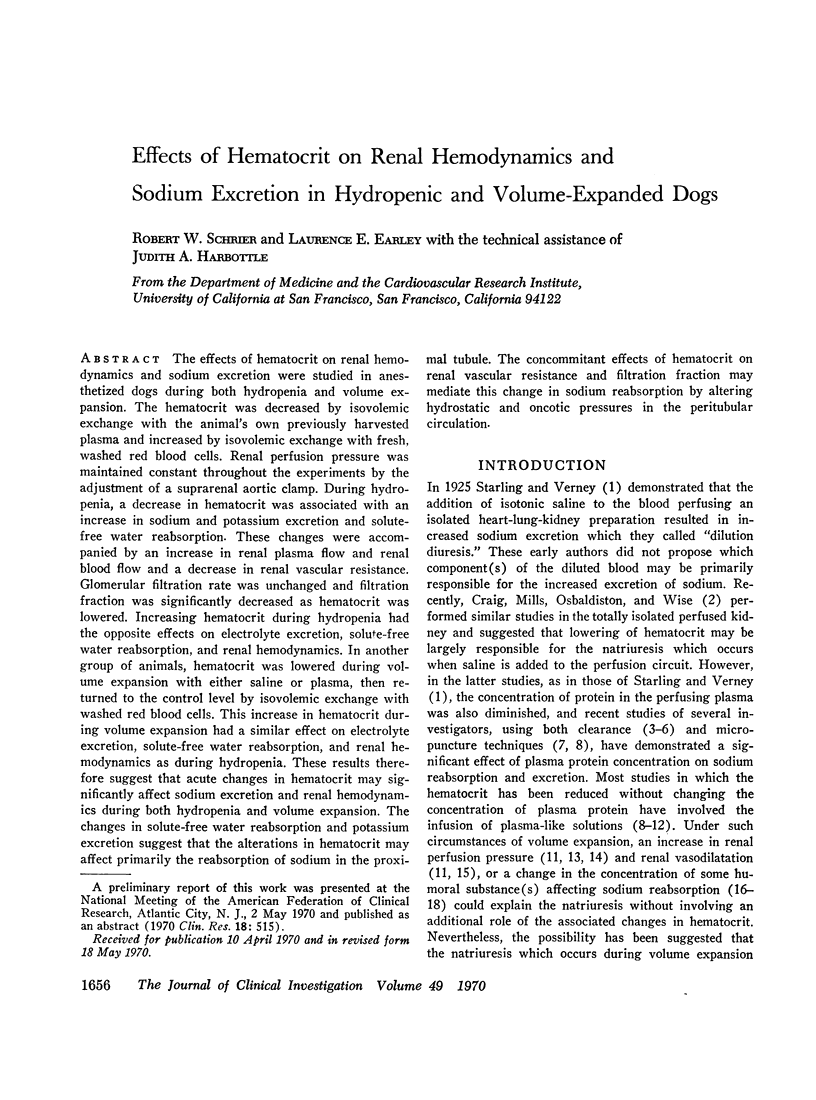
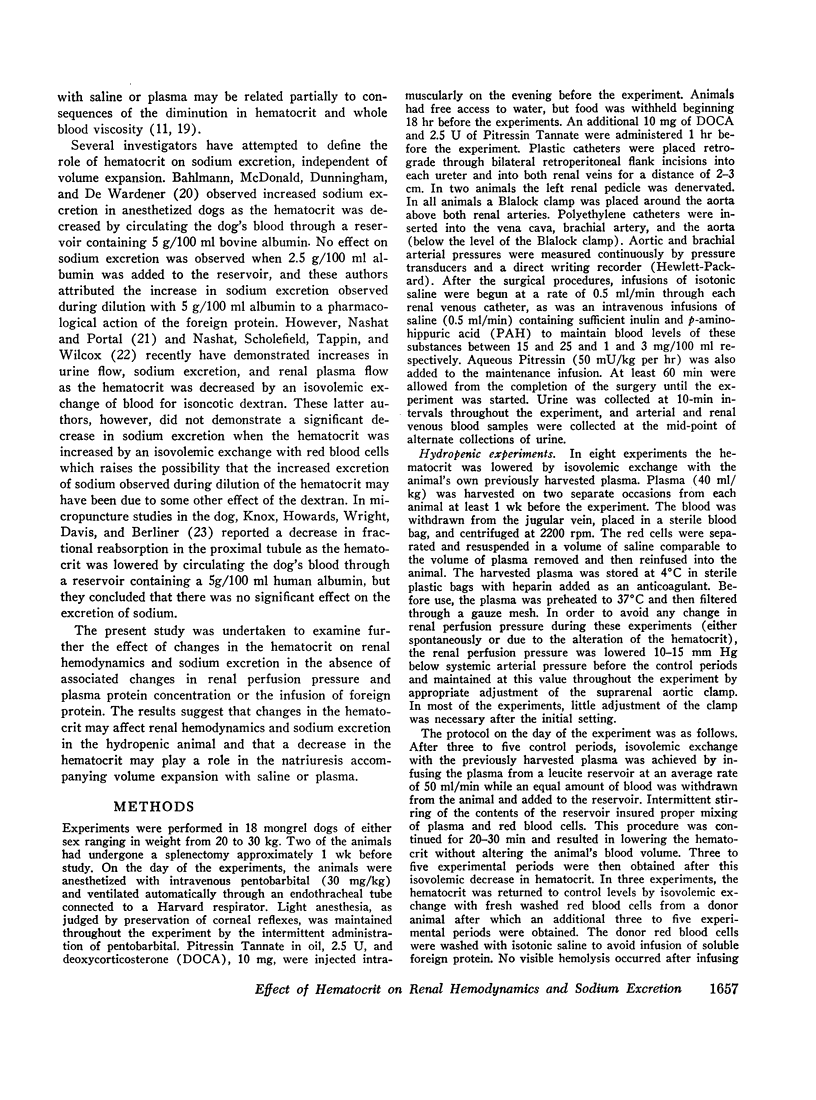
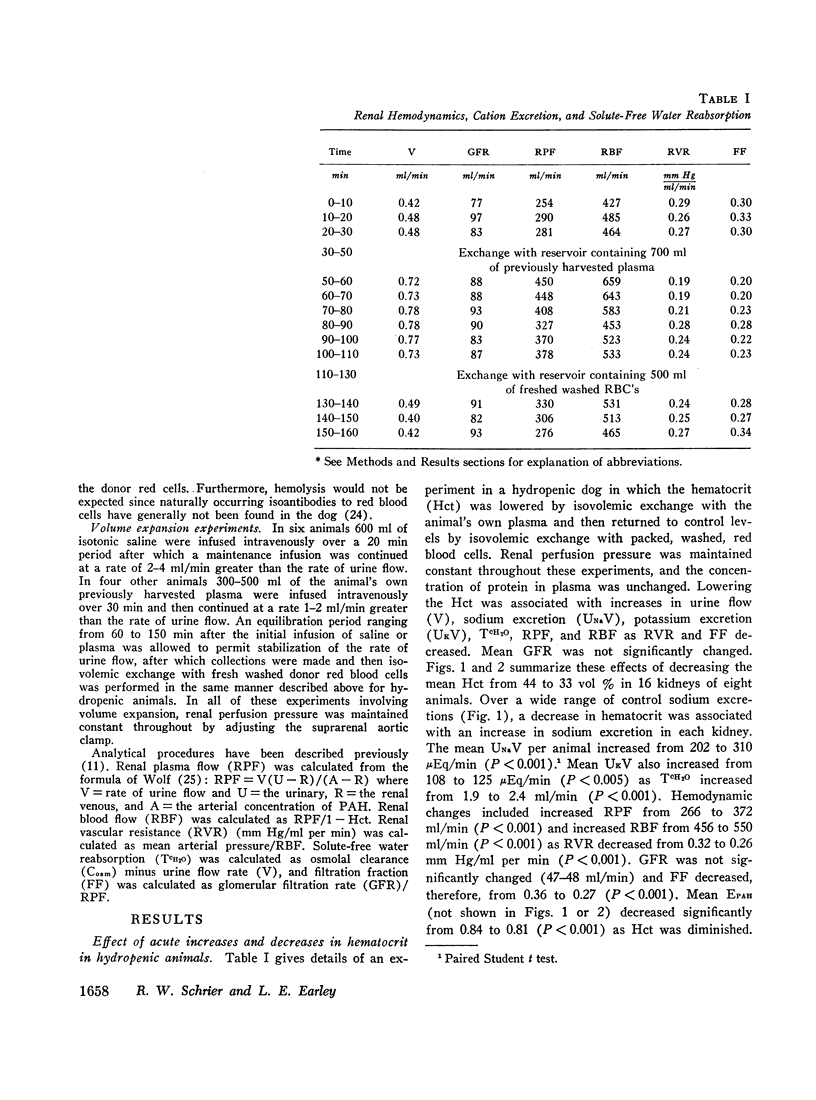
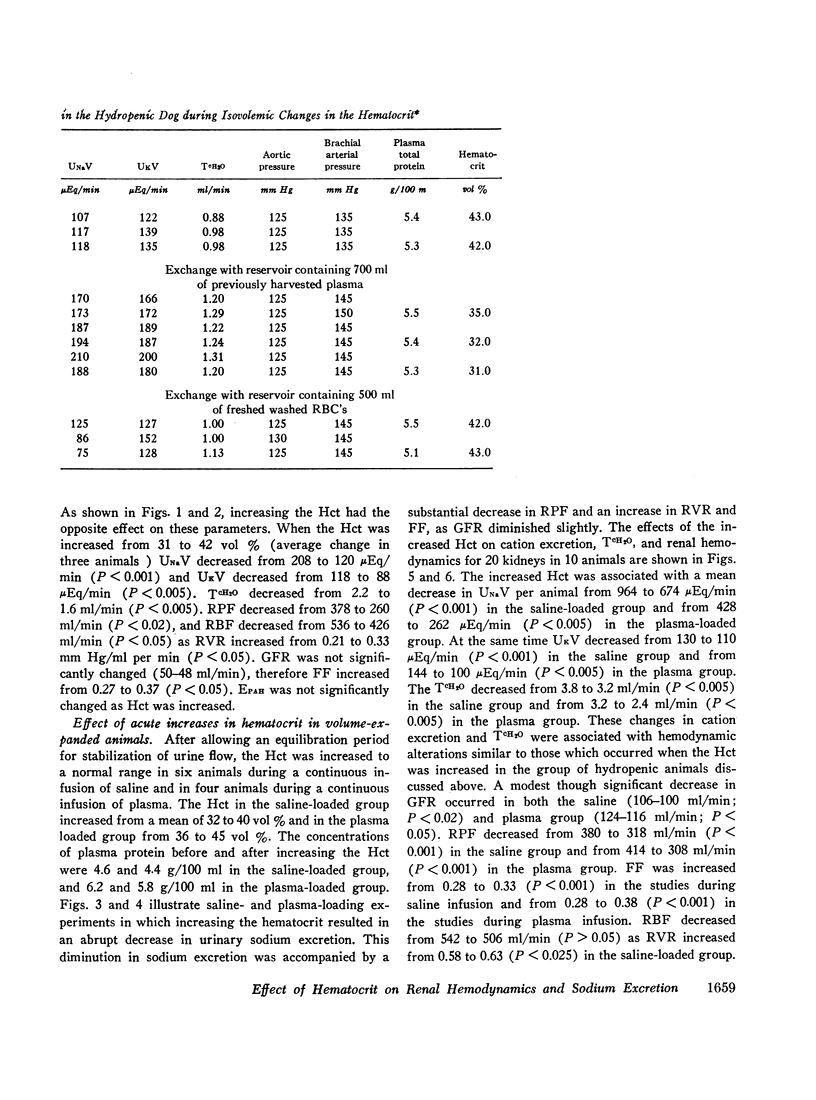
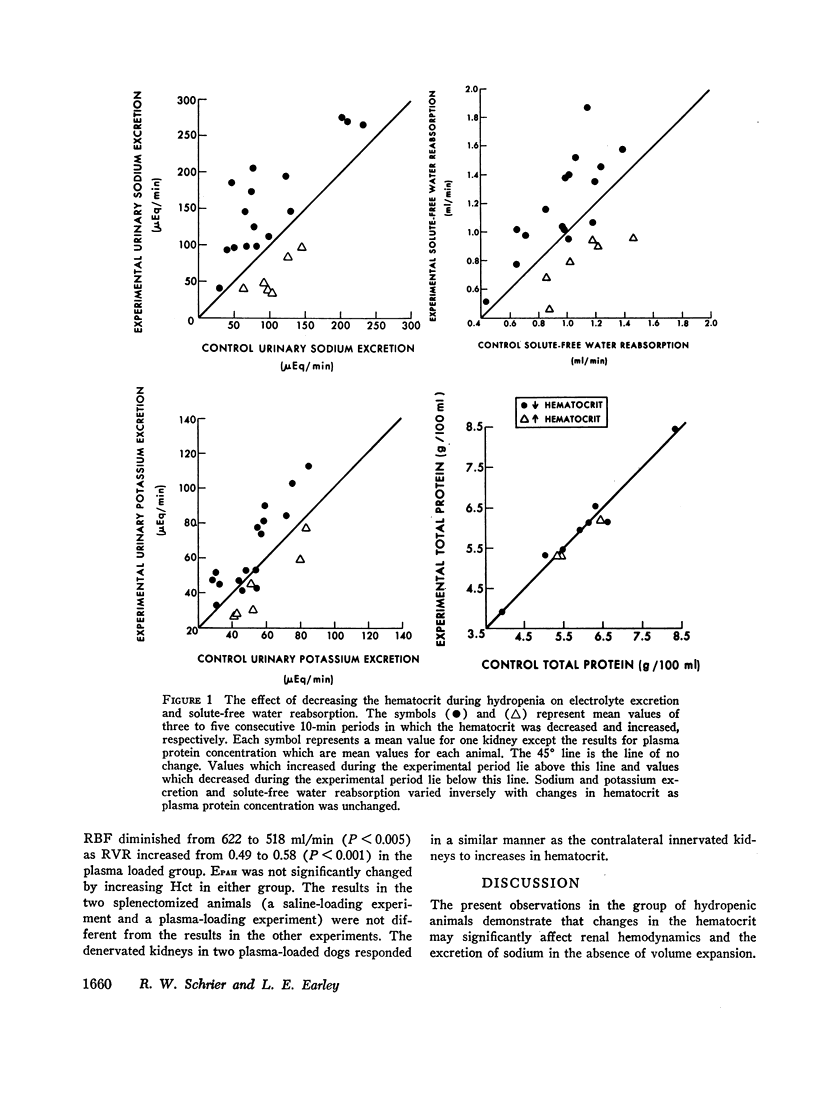
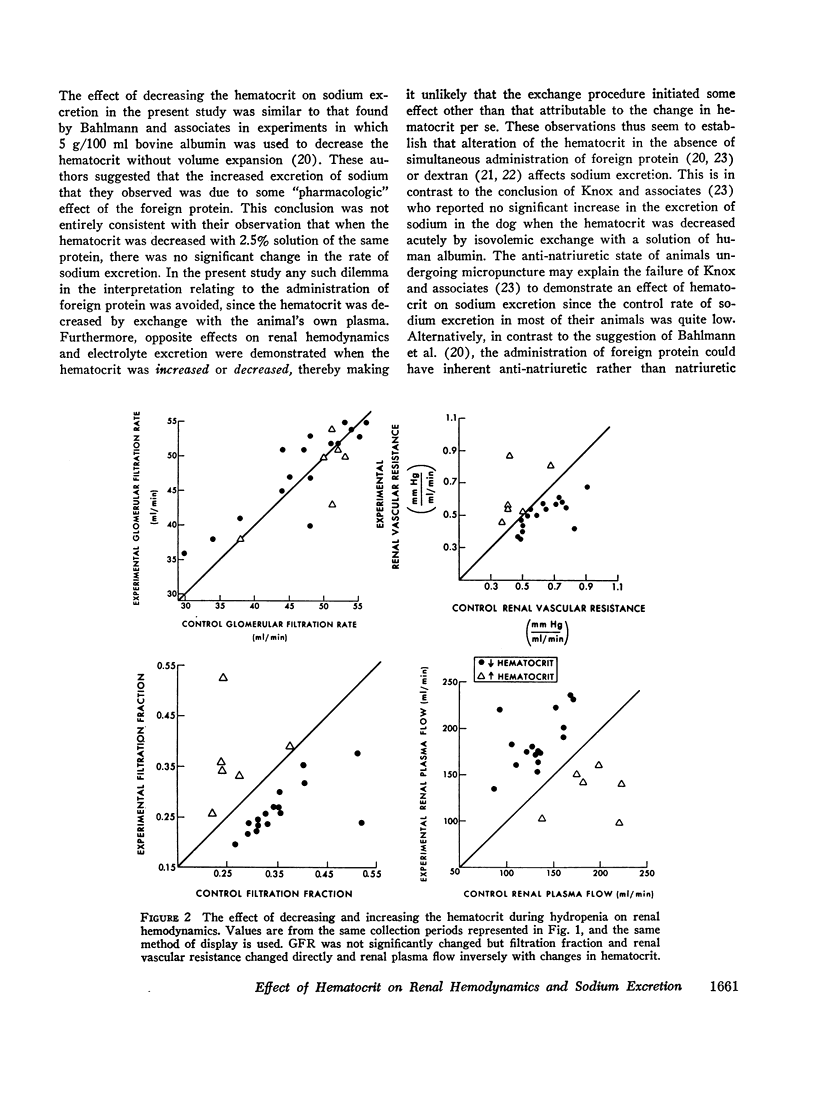
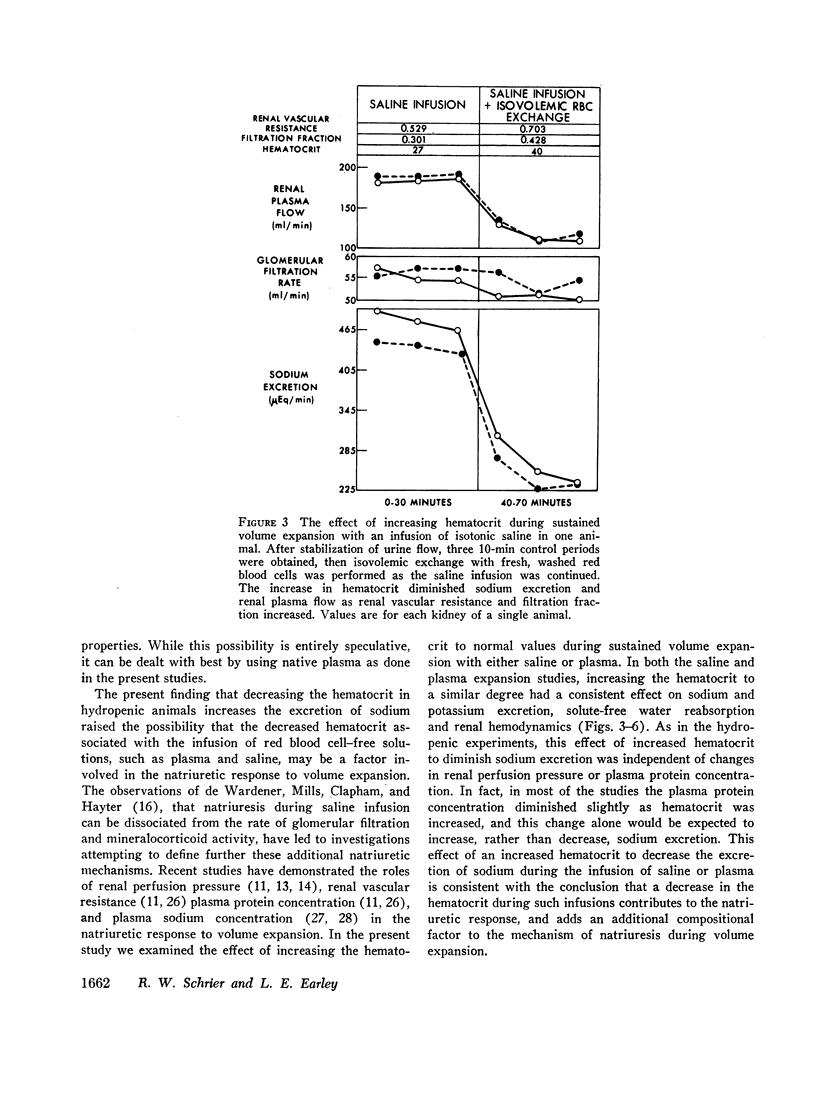
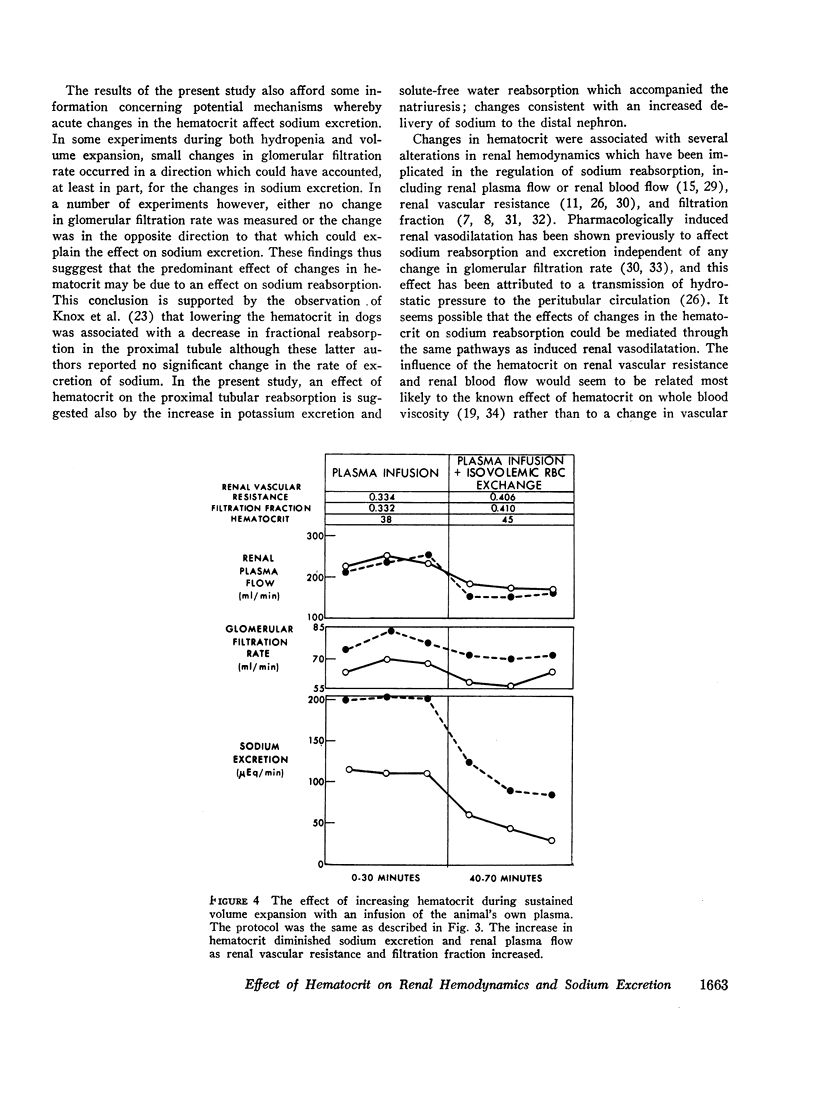
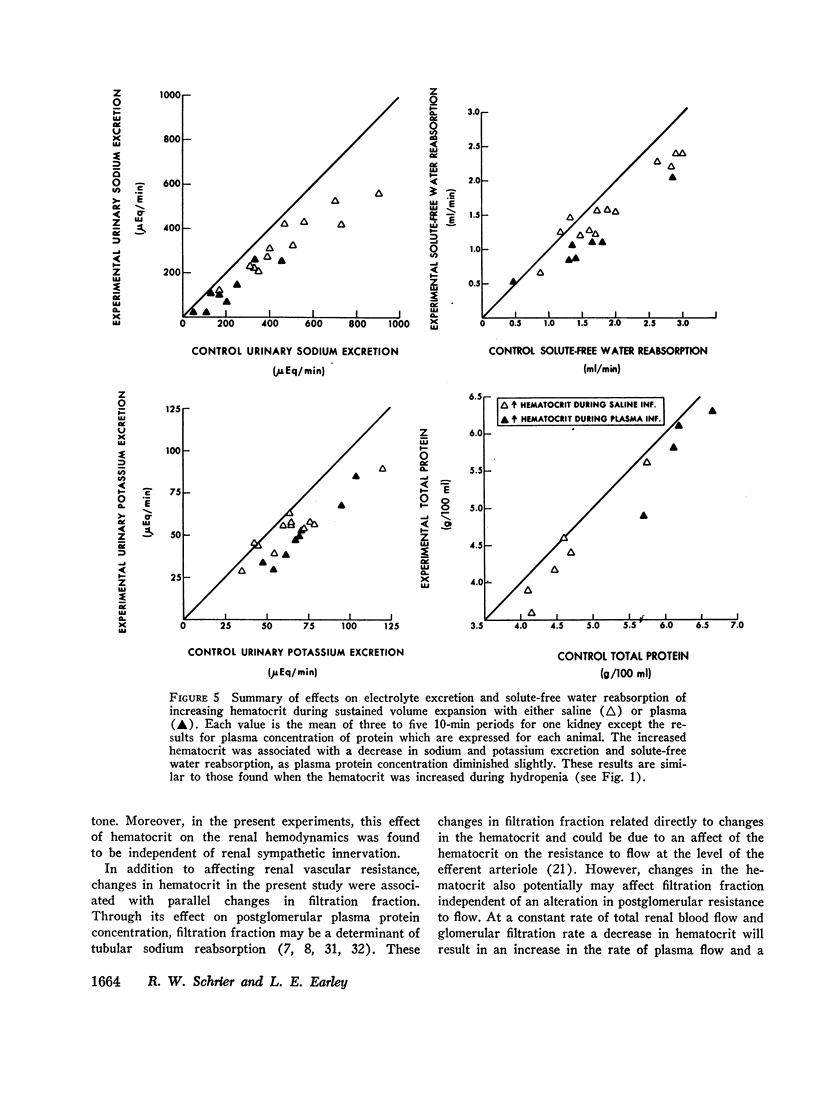
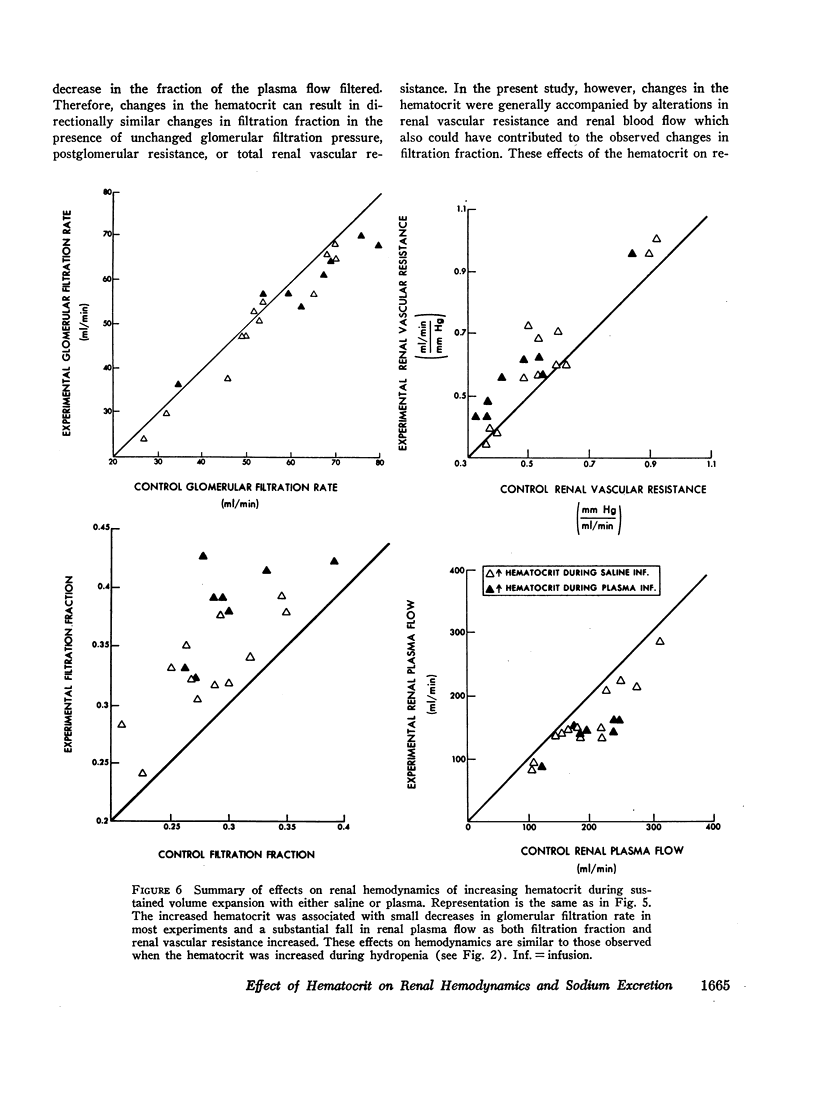
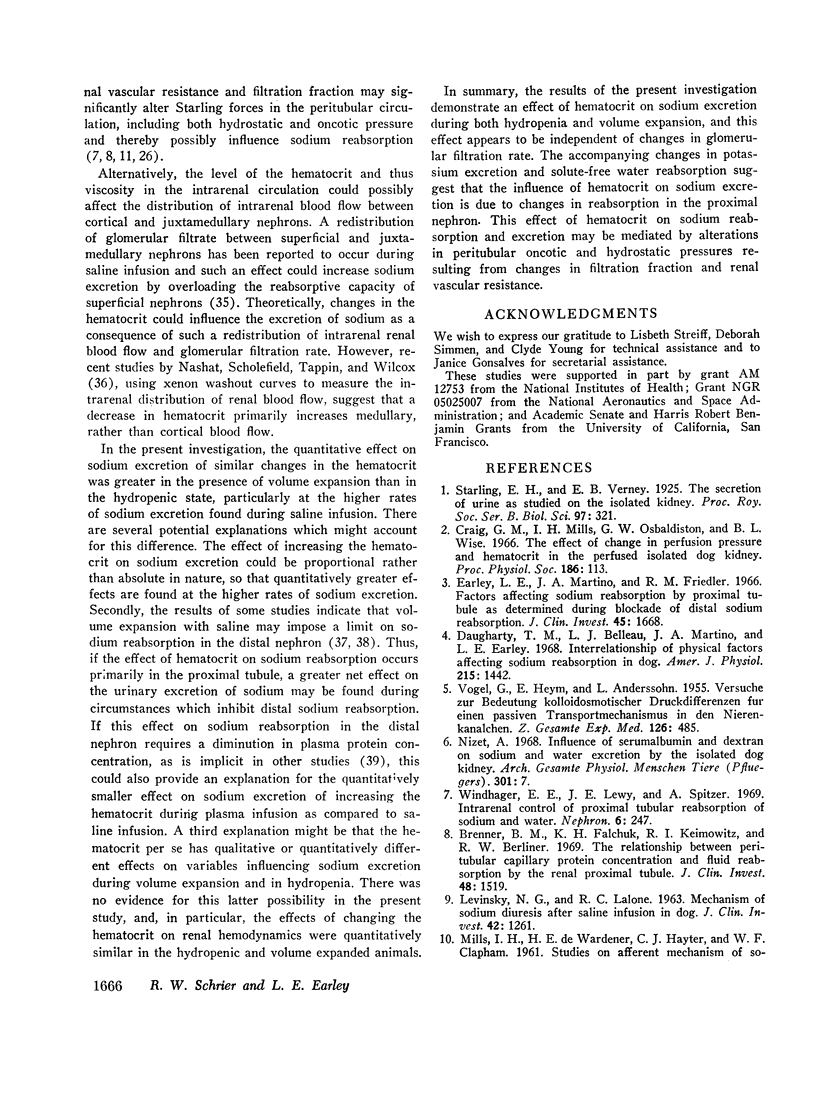
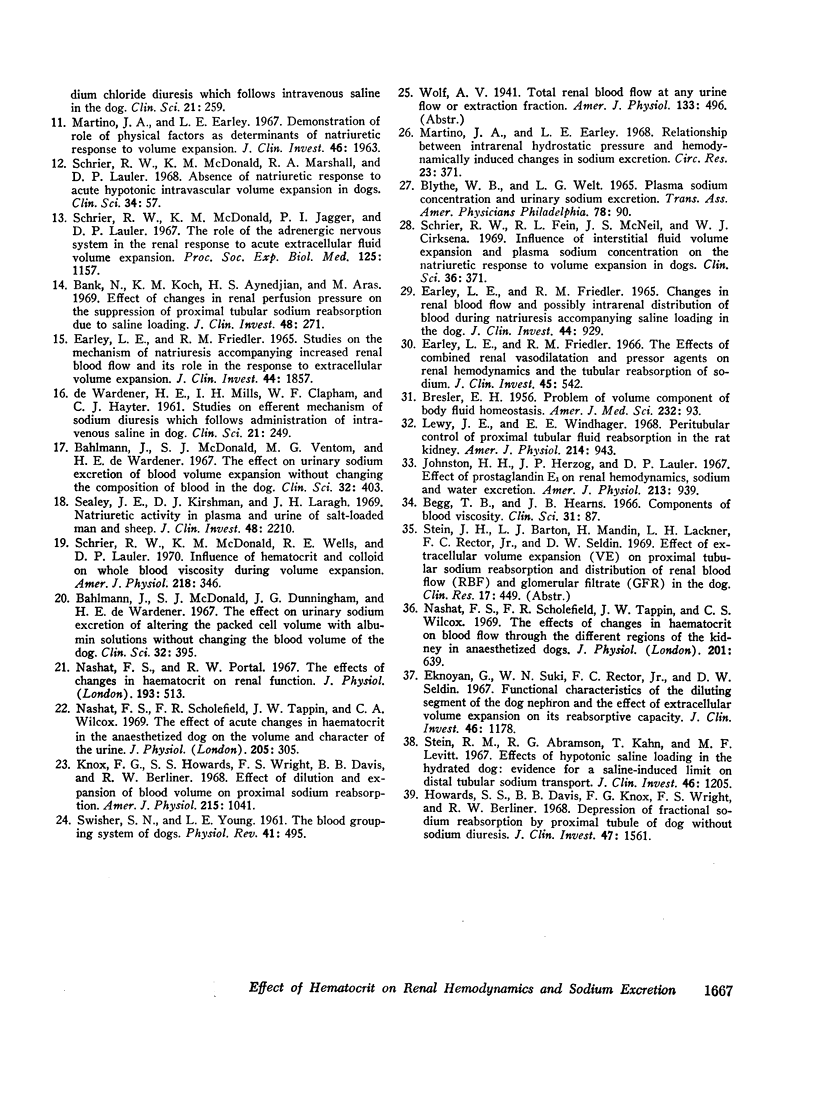
Selected References
These references are in PubMed. This may not be the complete list of references from this article.
- BRESLER E. H. The problem of the volume component of body fluid homeostasis. Am J Med Sci. 1956 Jul;232(1):93–104. doi: 10.1097/00000441-195607000-00014. [DOI] [PubMed] [Google Scholar]
- Bahlmann J., McDonald S. J., Dunningham J. G., De Wardener H. E. The effect on urinary sodium excretion of altering the packed cell volume with albumin solutions without changing the blood volume in the dog. Clin Sci. 1967 Jun;32(3):395–402. [PubMed] [Google Scholar]
- Bahlmann J., McDonald S. J., Ventom M. G., De Wardener H. E. The effect on urinary sodium excretion of blood volume expansion without changing the composition of blood in the dog. Clin Sci. 1967 Jun;32(3):403–413. [PubMed] [Google Scholar]
- Bank N., Koch K. M., Aynedjian H. S., Aras M. Effect of changes in renal perfusion pressure on the suppression of proximal tubular sodium reabsorption due to saline loading. J Clin Invest. 1969 Feb;48(2):271–283. doi: 10.1172/JCI105983. [DOI] [PMC free article] [PubMed] [Google Scholar]
- Begg T. B., Hearns J. B. Components in blood viscosity. The relative contribution of haematocrit, plasma fibrinogen and other proteins. Clin Sci. 1966 Aug;31(1):87–93. [PubMed] [Google Scholar]
- Blythe W. B., Welt L. G. Plasma sodium concentrations and urinary sodium excretion. Trans Assoc Am Physicians. 1965;78:90–96. [PubMed] [Google Scholar]
- Brenner B. M., Falchuk K. H., Keimowitz R. I., Berliner R. W. The relationship between peritubular capillary protein concentration and fluid reabsorption by the renal proximal tubule. J Clin Invest. 1969 Aug;48(8):1519–1531. doi: 10.1172/JCI106118. [DOI] [PMC free article] [PubMed] [Google Scholar]
- DE WARDENER H. E., MILLS I. H., CLAPHAM W. F., HAYTER C. J. Studies on the efferent mechanism of the sodium diuresis which follows the administration of intravenous saline in the dog. Clin Sci. 1961 Oct;21:249–258. [PubMed] [Google Scholar]
- Daugharty T. M., Belleau L. J., Martino J. A., Earley L. E. Interrelationship of physical factors affecting sodium reabsorption in the dog. Am J Physiol. 1968 Dec;215(6):1442–1447. doi: 10.1152/ajplegacy.1968.215.6.1442. [DOI] [PubMed] [Google Scholar]
- EARLEY L. E., FRIEDLER R. M. CHANGES IN RENAL BLOOD FLOW AND POSSIBLY THE INTRARENAL DISTRIBUTION OF BLOOD DURING THE NATRIURESIS ACCOMPANYING SALINE LOADING IN THE DOG. J Clin Invest. 1965 Jun;44:929–941. doi: 10.1172/JCI105210. [DOI] [PMC free article] [PubMed] [Google Scholar]
- Earley L. E., Friedler R. M. Studies on the mechanism of natriuresis accompanying increased renal blood flow and its role in the renal response to extracellular volume expansion. J Clin Invest. 1965 Nov;44(11):1857–1865. doi: 10.1172/JCI105293. [DOI] [PMC free article] [PubMed] [Google Scholar]
- Earley L. E., Friedler R. M. The effects of combined renal vasodilatation and pressor agents on renal hemodynamics and the tubular reabsorption of sodium. J Clin Invest. 1966 Apr;45(4):542–551. doi: 10.1172/JCI105368. [DOI] [PMC free article] [PubMed] [Google Scholar]
- Earley L. E., Martino J. A., Friedler R. M. Factors affecting sodium reabsorption by the proximal tubule as determined during blockade of distal sodium reabsorption. J Clin Invest. 1966 Nov;45(11):1668–1684. doi: 10.1172/JCI105474. [DOI] [PMC free article] [PubMed] [Google Scholar]
- Eknoyan G., Suki W. N., Rector F. C., Jr, Seldin D. W. Functional characteristics of the diluting segment of the dog nephron and the effect of extracellular volume expansion on its reabsorptive capacity. J Clin Invest. 1967 Jul;46(7):1178–1188. doi: 10.1172/JCI105611. [DOI] [PMC free article] [PubMed] [Google Scholar]
- Howards S. S., Davis B. B., Knox F. G., Wright F. S., Berliner R. W. Depression of fractional sodium reabsorption by the proximal tubule of the dog without sodium diuresis. J Clin Invest. 1968 Jul;47(7):1561–1572. doi: 10.1172/JCI105848. [DOI] [PMC free article] [PubMed] [Google Scholar]
- Johnston H. H., Herzog J. P., Lauler D. P. Effect of prostaglandin E1 on renal hemodynamics, sodium and water excretion. Am J Physiol. 1967 Oct;213(4):939–946. doi: 10.1152/ajplegacy.1967.213.4.939. [DOI] [PubMed] [Google Scholar]
- Knox F. G., Howards S. S., Wright F. S., Davis B. B., Berliner R. W. Effect of dilution and expansion of blood volume on proximal sodium reabsorption. Am J Physiol. 1968 Nov;215(5):1041–1048. doi: 10.1152/ajplegacy.1968.215.5.1041. [DOI] [PubMed] [Google Scholar]
- LEVINSKY N. G., LALONE R. C. THE MECHANISM OF SODIUM DURESIS AFTER SALINE INFUSION IN THE DOG. J Clin Invest. 1963 Aug;42:1261–1276. doi: 10.1172/JCI104811. [DOI] [PMC free article] [PubMed] [Google Scholar]
- Lewy J. E., Windhager E. E. Peritubular control of proximal tubular fluid reabsorption in the rat kidney. Am J Physiol. 1968 May;214(5):943–954. doi: 10.1152/ajplegacy.1968.214.5.943. [DOI] [PubMed] [Google Scholar]
- MILLS I. H., DE WARDENER H. E., HAYTER C. J., CLAPHAM W. F. Studies on the afferent mechanism of the sodium chloride diuresis which follows intravenous saline in the dog. Clin Sci. 1961 Oct;21:259–264. [PubMed] [Google Scholar]
- Martino J. A., Earley L. E. Demonstraton of a role of physical factors as determinants of the natriuretic response to volume expansion. J Clin Invest. 1967 Dec;46(12):1963–1978. doi: 10.1172/JCI105686. [DOI] [PMC free article] [PubMed] [Google Scholar]
- Martino J. A., Earley L. E. Relationship between intrarenal hydrostatic pressure and hemodynamically induced changes in sodium excretion. Circ Res. 1968 Sep;23(3):371–386. doi: 10.1161/01.res.23.3.371. [DOI] [PubMed] [Google Scholar]
- Nashat F. S., Portal R. W. The effects of changes in haematocrit on renal function. J Physiol. 1967 Dec;193(3):513–522. doi: 10.1113/jphysiol.1967.sp008375. [DOI] [PMC free article] [PubMed] [Google Scholar]
- Nashat F. S., Scholefield F. R., Tappin J. W., Wilcox C. S. The effect of acute changes in haematocrit in the anaesthetized dog on the volume and character of the urine. J Physiol. 1969 Nov;205(2):305–316. doi: 10.1113/jphysiol.1969.sp008966. [DOI] [PMC free article] [PubMed] [Google Scholar]
- Nashat F. S., Scholefield F. R., Tappin J. W., Wilcox C. S. The effects of changes in haematocrit on the intrarenal distribution of blood flow in the dog's kidney. J Physiol. 1969 May;201(3):639–655. doi: 10.1113/jphysiol.1969.sp008777. [DOI] [PMC free article] [PubMed] [Google Scholar]
- SWISHER S. N., YOUNG L. E. The blood grouping systems of dogs. Physiol Rev. 1961 Jul;41:495–520. doi: 10.1152/physrev.1961.41.3.495. [DOI] [PubMed] [Google Scholar]
- Schrier R. W., Fein R. L., McNeil J. S., Cirksena W. J. Influence of interstitial fluid volume expansion and plasma sodium concentration on the natriuretic response to volume expansion in dogs. Clin Sci. 1969 Jun;36(3):371–385. [PubMed] [Google Scholar]
- Schrier R. W., McDonald K. M., Jagger P. I., Lauler D. P. The role of the adrenergic nervous system in the renal response to acute extracellular fluid volume expansion. Proc Soc Exp Biol Med. 1967 Aug-Sep;125(4):1157–1162. doi: 10.3181/00379727-125-32302. [DOI] [PubMed] [Google Scholar]
- Schrier R. W., McDonald K. M., Marshall R. A., Lauler D. P. Absence of natriuretic response to acute hypotonic intravascular volume expansion in dogs. Clin Sci. 1968 Feb;34(1):57–72. [PubMed] [Google Scholar]
- Schrier R. W., McDonald K. M., Wells R. E., Lauler D. P. Influence of hematocrit and colloid on whole blood viscosity during volume expansion. Am J Physiol. 1970 Feb;218(2):346–352. doi: 10.1152/ajplegacy.1970.218.2.346. [DOI] [PubMed] [Google Scholar]
- Sealey J. E., Kirshman J. D., Laragh J. H. Natriuretic activity in plasma and urine of salt-loaded man and sheep. J Clin Invest. 1969 Dec;48(12):2210–2224. doi: 10.1172/JCI106187. [DOI] [PMC free article] [PubMed] [Google Scholar]
- Stein R. M., Abramson R. G., Kahn T., Levitt M. F. Effects of hypotonic saline loading in hydrated dog: evidence for a saline-induced limit on distal tubular sodium transport. J Clin Invest. 1967 Jul;46(7):1205–1214. doi: 10.1172/JCI105614. [DOI] [PMC free article] [PubMed] [Google Scholar]
- VOGEL G., HEYM E., ANDERSSOHN K. Versuche zur Bedeutung kolloidosmotischer Druckdifferenzen für einen passiven Transportmechanismus in der Nierenkanälchen. Z Gesamte Exp Med. 1955;126(5):485–495. [PubMed] [Google Scholar]
- Windhager E. E., Lewy J. E., Spitzer A. Intrarenal control of proximal tubular reabsorption of sodium and water. Nephron. 1969;6(3):247–259. doi: 10.1159/000179732. [DOI] [PubMed] [Google Scholar]


